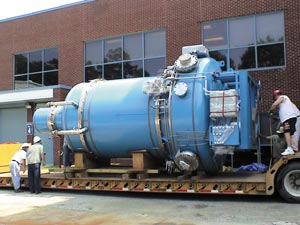A recent meeting at Jefferson Lab has inaugurated a new biennial workshop on reducing operating costs and increasing stability and reliability in a new generation of refrigeration plants for superconducting accelerators. Steven Corneliussen reports.

Accelerators and light sources rely increasingly on superconducting magnets, superconducting accelerating structures and other very-low-temperature equipment. At the same time there has also been progress in understanding the design, operation and optimization of the refrigeration plants needed to provide the cooling. To speed the evolution of this understanding and to foster its practical application, cryogenics engineers have instituted a new biennial meeting. The first Workshop on Cryogenics Operations was held on 30 March – 2 April at the US Department of Energy’s Thomas Jefferson National Accelerator Facility (Jefferson Lab) in Newport News, Virginia, with participants attending from Europe and America.
A cryogenics plant’s operating expenses include manpower, electricity, helium refrigerant gas and liquid nitrogen. At Jefferson Lab, for example, the 2 K plant supporting the Continuous Electron Beam Accelerator Facility (CEBAF) and a free-electron laser user-facility requires several staff and $3.5 million (€2.8 million) per year for electricity, plus another $850,000 (€690,000) for liquid nitrogen and $400,000 (€325,000) for helium.

Recent cryogenics upgrades at Brookhaven National Laboratory’s Relativistic Heavy Ion Collider (RHIC) illustrate how such operating costs can be controlled and how system reliability can be raised. RHIC’s system maintains the superconducting magnets in two collider rings at or below 4.6 K. At the workshop Ahmed Sidi-Yekhlef from the RHIC project described how a new approach to process control, coupled with hardware modifications, yielded a power reduction of about 20% (1.8 MW) while boosting system reliability, stability and flexibility, with less human intervention. In RHIC’s new process control system the refrigerant charge pressure of the cryogenic system is continuously varied automatically to match the imposed cryogenic load of the superconducting magnets. The lower system charge pressures reduce the mechanical loading and wear on the refrigerator’s main helium gas compressors, which are electrically driven. The result is savings in electrical power, maintenance and repairs.
The workshop participants took special note of how cryogenics operations of this kind of increasing sophistication are being applied to coming generations of machines. As discussed at the meeting, the first stage of the refrigeration system for the Large Hadron Collider is now installed and ready for cooling tests in 2005. Presentations and discussions during the workshop also described progress with the cryogenics systems at ISAC-II, the superconducting-linac-based upgrade of the radioactive beam facility at TRIUMF in British Columbia, and at the Spallation Neutron Source (SNS) at Oak Ridge National Laboratory in Tennessee.
The SNS will serve as the next-generation neutron-scattering facility for the US, providing the most intense pulsed neutron beams in the world for scientific research and industrial development. With a total cost of $1.4 billion (€1.1 billion), construction of the SNS began in 1999 and will be completed in 2006. At the heart of the new facility is a superconducting accelerator cooled by a 2400 W, 2.1 K helium cryogenic system, with a shield load of 8300 W at 38 K. The system was designed and built in partnership with Jefferson Lab for unattended operation with greater than 99% reliability. At the workshop, Dana Arenius of Jefferson Lab and Donald Richied of SNS reported on how the design phase had focused on this new optimization approach, which uses automatic pressure-reduction control to match the variations in the facility’s cryomodule load. The efficiency of the plant is maintained with lower operating costs while extending the service lifetimes of major components. Comparable technology for unattended operation has been proven in operation at Michigan State University’s National Superconducting Cyclotron Laboratory.
Arenius chaired the workshop, and there were substantial contributions from Ganni Rao, also from Jefferson Lab. Because the laboratory expects to participate in future projects much as it has in the construction of the SNS, the Accelerator Division has been especially motivated to initiate and stimulate critical thinking concerning cryogenics optimization. Raymond L Orbach, who directs the US Department of Energy’s Office of Science, recently announced a prioritized list of more than two dozen major future scientific facilities and upgrades for the next 20 years. High-field superconducting magnets or superconducting microwave technology will figure in around a third of these, including the Rare-Isotope Accelerator and the Linac Coherent Light Source, for which the prospects for cryogenics operation were discussed during the meeting.
John Weisend of SLAC will chair the second Workshop on Cryogenics Operations, to be held in 2006, probably with Japanese participation, and CERN is contemplating hosting in 2008. The workshop complements the biennial Cryogenic Engineering Conference, which occurs in odd-numbered years and focuses on the broad field of breakthroughs in cryogenic technology and cryogenic industrial products.







